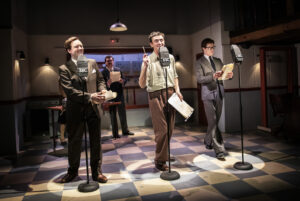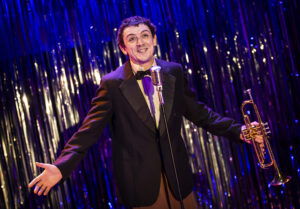An entertaining look at a comic genius but without his anarchic spirit
★★★

Spike by Nick Newman and Ian Hislop at The Watermill Theatre is a labour of love. Spike Milligan had a long association with Private Eye and the authors, both from the magazine, clearly feel great affection for him. However, they faced three challenges in conveying his comic genius, and weren’t entirely successful in overcoming them, despite devising an entertaining play
Firstly, I’m not sure that many people under 60 will know about Spike Milligan or remember The Goon Show. He was a brilliant comic writer and performer, best known as the writer of The Goon Show. Trouble is, the last Goon Show to be transmitted on what was then called the BBC Home Service was back in 1960, followed by a couple TV specials over the next decade or so.
It was Milligan’s surrealist and absurd humour that made The Goon Show a phenomenal hit. He was an acknowledged influence on future comedies and comics including Monty Python and Eddie Izzard.
After The Goons, Milligan continued to be a fountain of anarchic humour. He wrote poetry, plays, and books, and appeared in a number of TV programmes through the 70s and 80s. He died twenty years ago.
The Goon Show is still what he’s best known for and that’s what this play concentrates on. We see the early resistance from the BBC to the Spike’s revolutionary and rebellious style, through to the show becoming hugely popular. We also learn about Spike’s difficult personal life, his traumatic experience as a soldier in the second world war and his mental illness, and how the pressure of writing the Goon Show took its toll.
Secondly, the actors playing Milligan and his fellow Goons Peter Sellers and Harry Secombe cannot hope to recreate their genius: their voices, their timing, their understanding of each other, the way they perform as if they have just seen the script and are enjoying it as much as the audience.
Sensibly the cast don’t try to do impressions of the originals. Instead, they act out their own interpretation of these characters. Which makes it an interesting story about three friends but nothing like as funny as you might expect from a show about The Goons. The jokes are there, of course, particularly plays on words- a sign on Milligan’s door says ‘Do not disturb, I’m disturbed enough already’- but they cannot hope to deliver them with the power of the actual Goons. The voices can never be quite as ridiculous nor the irony as sharp.

I’m not in any way denigrating the actors. John Dagleish as Milligan is an excellent comic actor with a great plasticine face and he plays his part with verve, giving a strong impression of a man on the edge. George Kemp as Sellers and Jeremy Lloyd as Secombe provide excellent support. Robert Mountford represents the stiff voice of authority very well. Margaret Cabourn-Smith, James Mack and Ellie Morris complete a talented cast.
The tortured comic genius is a familiar trope. Stories of artists rebelling against and being rejected by the establishment until they are finally embraced are familiar too. But, in the case of Milligan, it’s a tale still worth telling.
To beef up the laughs, the writers cleverly weave in an almost discrete story about the sound effects. Sound effects were an important part of The Goon Show. Spike Milligan set the challenge of producing surreal sound effects. Margaret Cabourn-Smith, in Joyce Grenfell mode, humorously explains how they were achieved. Perhaps because the audience has no ‘original’ to compare this with, she gets the most enthusiastic response of the evening.
Director Paul Hart, who is The Watermill’s Artistic Director, keeps up a good pace, so you won’t be bored. Katie Lias helps with a set designed to change quickly from a recording studio to various offices, a battleground, a pub and Spike’s home. She uses the back of the stage well. Often there are Milligan-ish cartoons telling us the location of the scene, and projections high up suggest the state of Milligan’s mind.
Which brings me to the third challenge. In a play mainly about Milligan’s mental state, how do you convey his exploding mind? Yes, John Dagleish sparks with happiness and crumples with despair, and yes, the story tells us how, in his mind, his battle with army officers becomes a battle with the BBC authorities. It’s an interesting observation of him but the play doesn’t get inside his head. It’s conventional in a way that Milligan would never have been. In producing a tribute to Spike Milligan, maybe Nick Newman and Ian Hislop should have injected their play with more of their hero’s anarchic spirit.
Spike is at The Watermill Theatre in Newbury until 5 March 2022
Paul received a complimentary review ticket from the producers.
Click here to watch this review of Spike on YouTube